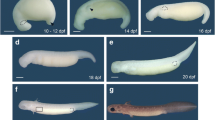Abstract
During the period of early organogenesis the mouse embryo has a curved body shape, which is thought to interact with ongoing developmental processes. Curly tail is a mouse mutant causing spina bifida, in which aberrant axial curvature is considered to be responsible for a delay in the closure of the posterior neuropore (PNP). Since detailed descriptions of axial curvature have never been made in either the normal or the mutant embryo, the onset and development of the aberrant axial curvature in the curly tail embryo are unknown. In the present study, axial curvature and segmental growth during closure of the PNP are described using circle segments at each somite level in two non-mutant mouse strains. Using the radius and angle of the segments as parameters, CD-1 and Balb/c mouse embryos showed maxima of curvature at the levels of the limb buds. Throughout development, a general axial unbending occurred that was due to a level-specific combination of general outgrowth and other factors. A marked additional decrease in the axial curvature was spatially and temporally related to the final closure of the PNP, indicating that this decrease of curvature facilitates the final closure of the PNP. In the curly tail embryo the segment parameter radius was used to relate the axial curvature to an aberrant neural tube closure pattern. These embryos exhibited an enhanced curvature over the entire neuropore region as soon as a delay in the PNP closure could be distinguished. A steep decrease in curvature during final closure of the PNP did also occur, but at a more caudal level. Both the axial level of straightening and the rate of curvature were normalized at advanced developmental stages. The aberrant spatio-temporal curvature pattern in the curly tail mouse embryo indicates that both the rate of curvature and the axial level of unbending are important for a correct PNP closure.
Similar content being viewed by others
Author information
Authors and Affiliations
Additional information
Accepted: 2 September 1996
Rights and permissions
About this article
Cite this article
Peeters, M., Hekking, J., Vainas, T. et al. Spatio-temporal curvature pattern of the caudal body axis for non-mutant and curly tail mouse embryos during the period of caudal neural tube closure. Anat Embryol 195, 259–266 (1997). https://doi.org/10.1007/s004290050045
Issue Date:
DOI: https://doi.org/10.1007/s004290050045



